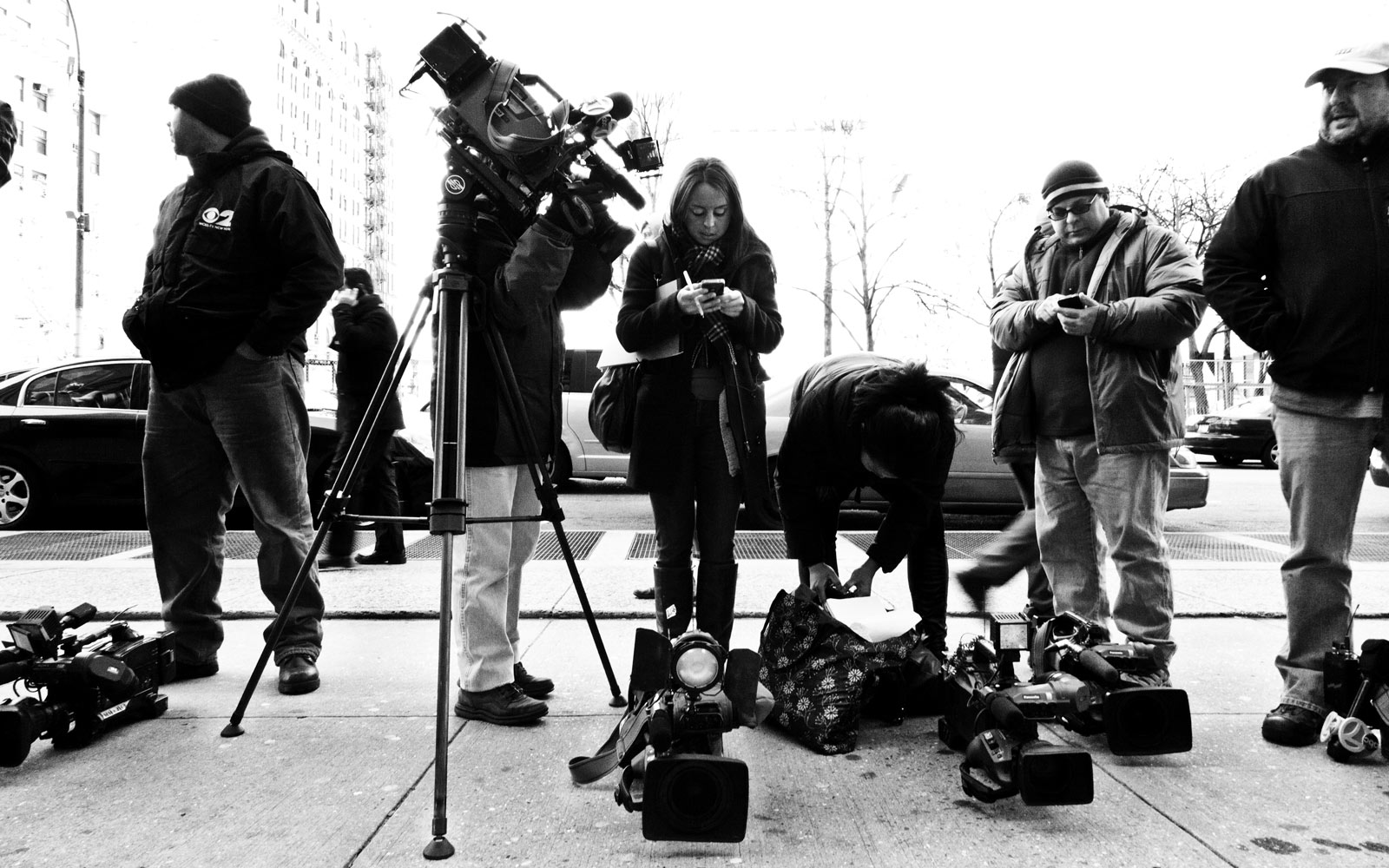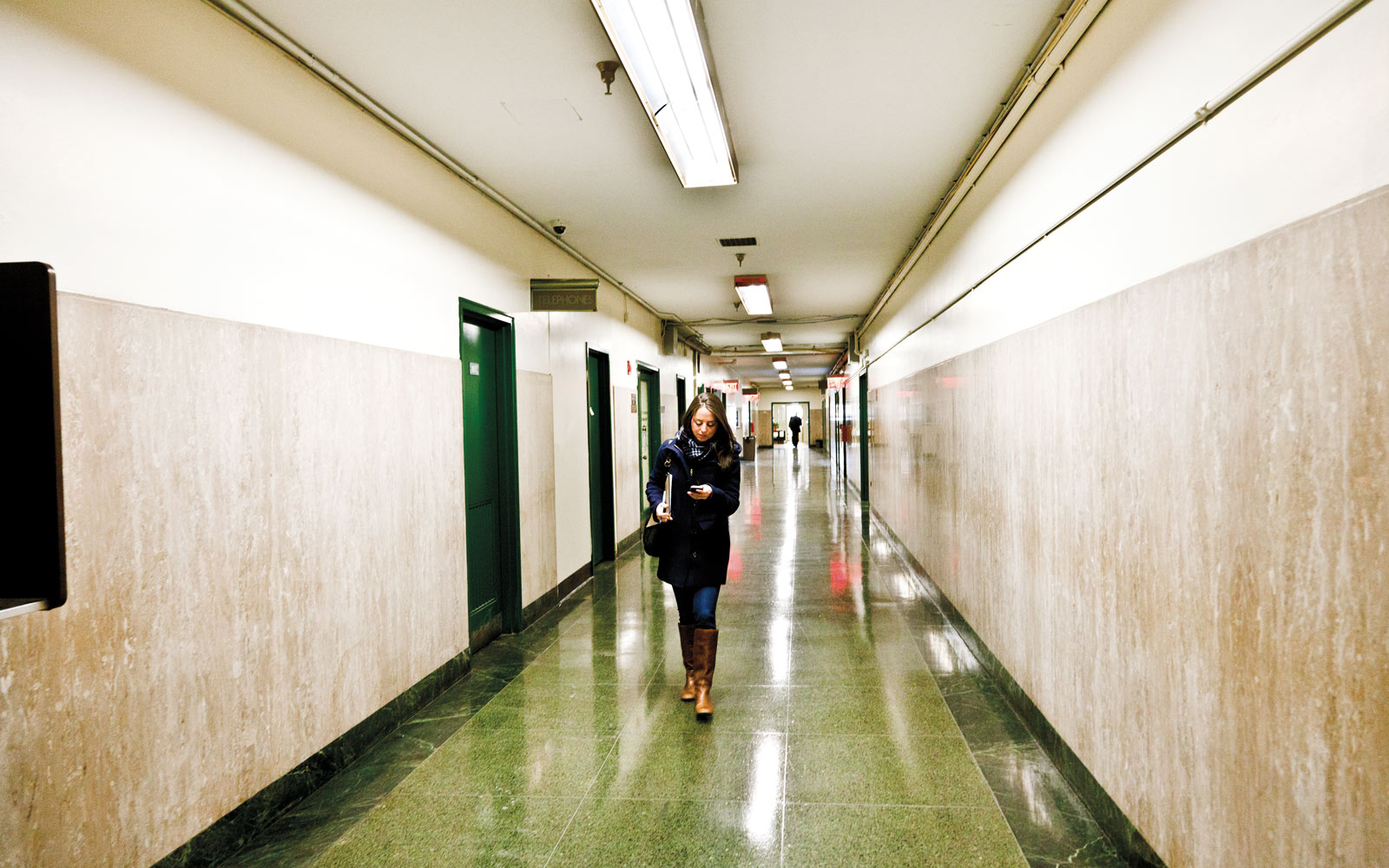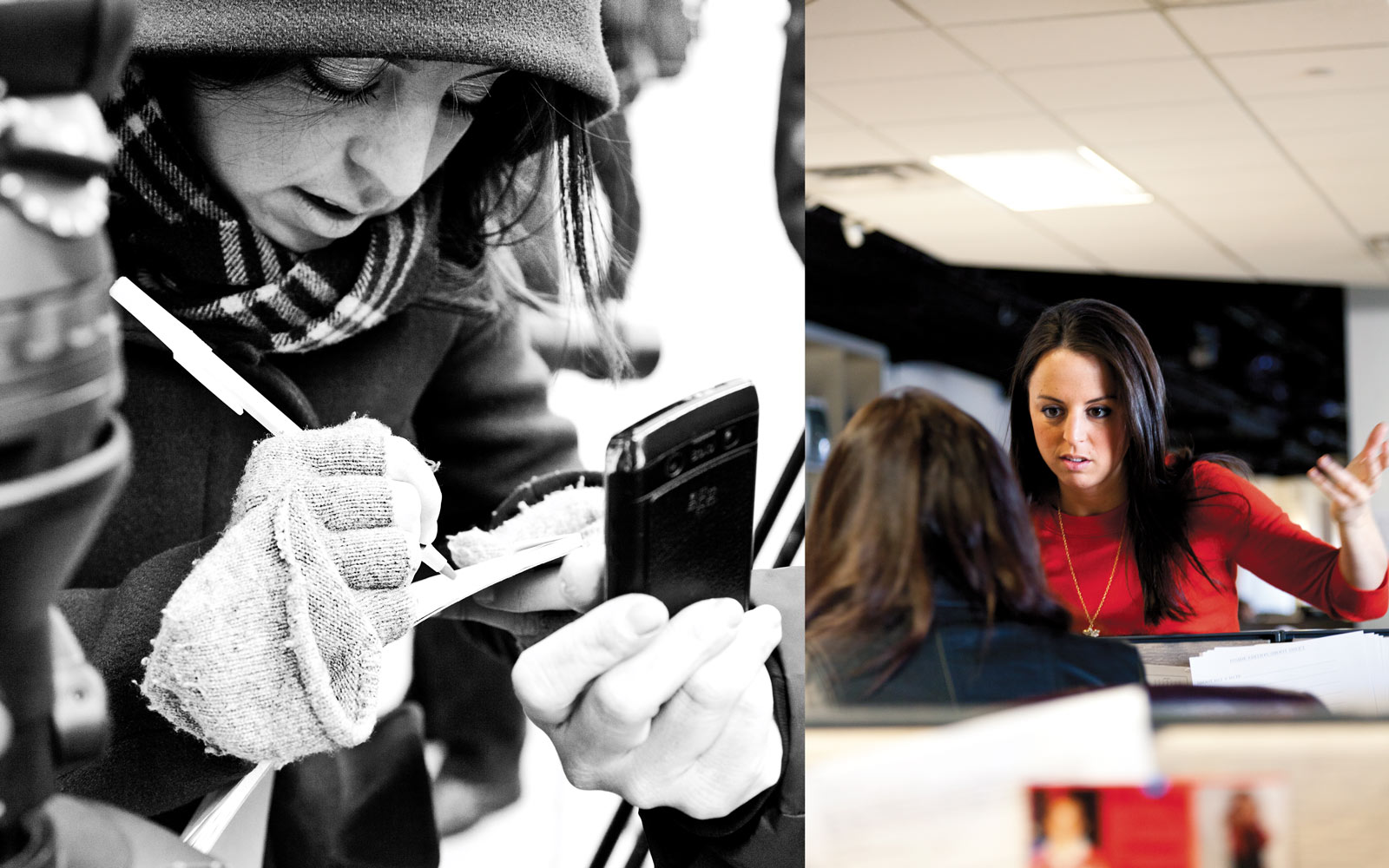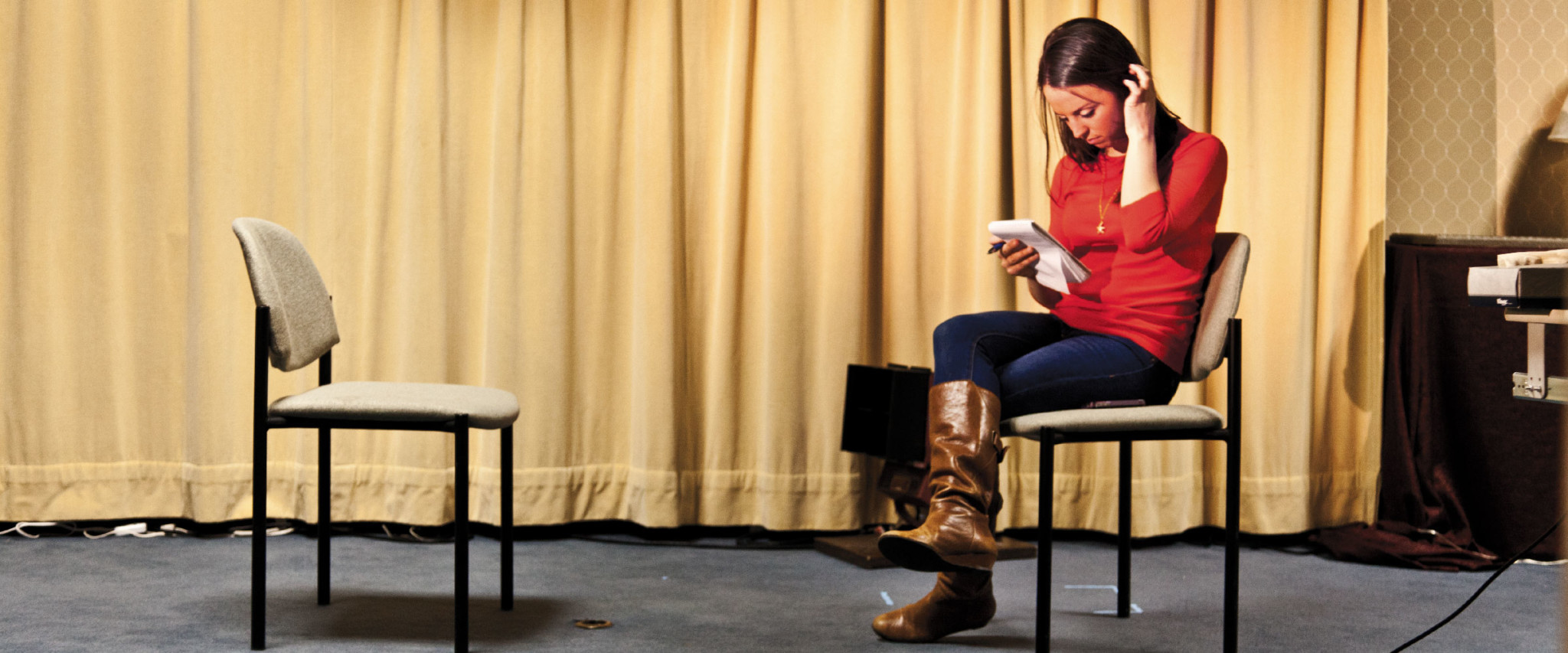It’s the Tuesday following the Oscars, and a Gwyneth Paltrow look-alike is having her make-up done as she sits in a folding chair in a small room on the fourth floor of Pearl Studios in New York City. Her tiny pink Ugg boots are dangling a foot off the ground, and she’s clutching a pair of mismatched socks. “They’re like her blankie,” her mom tells the woman with the lipstick. “Gwyneth” is a 4-year-old model who has been hired for a photo shoot with photographer Tricia Messeroux, owner of Toddlewood, a group that recreates Hollywood moments with tykes. A 6-year-old Angelina Jolie sits next to Gwen, whipping her huge false eyelashes around. Soon George Clooney’s girlfriend, Stacy Keibler, arrives. In walks Jennifer Lopez. Viola Davis. Octavia Spencer. They’re all accompanied by their parents. George Clooney even brings his grandma.
Across the room is the “set,” made up of two bright red carpets pushed together and a table draped in black with signs proclaiming, “The Academy Awards.”
Just a few minutes ago, videographer Warren Manos, soundman Jonathan Smith, and associate producer Maggie Hopf were dispatched from the Inside Edition offices, 20 blocks away. Their job today is to hang out at the shoot from 10 a.m. to 1:30 p.m., talking with the toddlers, getting before-and-after shots, and interviewing Messeroux for a couple of sound bites. They’ll spend nearly four hours collecting the video that the editors and producer will use to make a 60-second “story” that will go out on Inside Edition’s syndicated newsfeed at 3 p.m. In addition to making it back to the offices on time and with enough material to satisfy the producer, Hopf is feeling a tad worried about Angelina’s leg.
Yes, that leg. Or the 6-year-old version of the now iconic limb that struck a pose on the real red carpet and the Oscar stage.
Inside Edition can’t use the footage if the cut on the dress is too high. The kid is only 6 years old, after all. So Hopf starts trading a flurry of texts and calls to producer Colum Ward.
The leg is the most talked-about Oscar moment, and Ward wants the shot. So it’s Hopf’s job to spend a few seconds convincing the stressed and rushed photographer—who has use of the rented studio only until 2 p.m.—that they’ll need to lower the cut on the dress for a few seconds to get their shot. Messeroux looks at the clock and reluctantly agrees. Her team pins the dress above the knee and the crew takes rushed footage. A “runner” arrives from Inside Edition’s offices to pick up the XD disc and drive it back to Ward, who is waiting to begin editing and writing the script for anchor Deborah Norville. Hopf and her crew hang back and continue filming.

Maggie Hopf got to Inside Edition largely through a combination of determination, New York-style networking, and good old-fashioned luck. After graduating from Denison, Hopf asked her parents to drop her off in New York City as they headed out of town for a trip. Her plan was to camp out in a friend’s apartment for five weeks, send out resumés and follow-up emails, pound the pavement, and hope for the best. A friend of a friend of a friend got her a job doing “load-outs,” which basically meant that she’d show up at a predetermined location and unload or load sets for Broadway plays. She’d work for an hour or two and pocket $75 to $150. She worked as a temp at a printing company. She interviewed for a position on Maury, starring Maury Povich. She babysat.
And then there was the lunch meeting that would get her into the television news world. That friend who graciously allowed her to live in her apartment for five weeks? Turns out she was the soccer coach for the daughter of a 20/20 senior producer. Hopf’s pal pulled some strings and arranged a meeting. “I was terrified,” says Hopf. “I was at ABC with a 20/20 producer. I couldn’t believe this was happening to me.” The meeting went well, but there weren’t any open positions at 20/20. So for the next six weeks Hopf emailed the producer every Friday, trying to carefully walk the line that divides the determined from the annoying. Over time the woman helped her land interviews at Good Morning America and ABC World News. But nothing came of the meetings. Finally, when a staffer went out on maternity leave, Hopf came in to freelance as a booker in the development and booking department, which meant she’d pitch story ideas and help arrange interviews. It may have been an entry level position at 20/20, but the work wasn’t easy. “Being a booker is one of the toughest jobs,” says Hopf. “You really have to have a personality. You have to make people feel comfortable. You have to be honest. You have to call victims of crimes and the mothers of people in jail. It’s emotionally draining.” When the senior producer’s assistant resigned, Hopf took her place. She was answering phones and making appointments, but her career benefactress also pushed Hopf to pitch stories and act as a booker and production assistant. Eventually, she started booking more and answering the phone less.
In the 20/20 offices there are televisions everywhere. It’s the staff’s job, after all, to watch the news. Hopf remembers one particular Thursday when she was working while The Ellen Degeneres Show played in the background. She was just getting ready to leave the office when Channel 4 interrupted Ellen to show footage of a USAirways plane floating on the Hudson River.
At first everyone thought it was a movie set, but newscasters soon relayed the story of flight 1549, which, within minutes of takeoff, hit a flock of Canada geese, causing a loss of thrust in the engines. The crew guided the plane to a water landing. As the staff was watching the broadcast, the producers chose Hopf and another booker to head out to the scene. Their job was to see if any survivors would agree to be interviewed for the 20/20 episode, which would air just 30 hours later. “There was media from everywhere. Japan’s reporters were there,” she says. “Everyone was trying to get past the police tape.” After hours of waiting and pleading with folks to share their story, she headed home, discouraged. The next morning, she learned that 20/20’s partner show, Good Morning America, had landed a couple of interviews. So after GMA’s taping, she gathered the interviewees and took them to breakfast. She wanted them to refuel for the next set of interviews at 20/20. Over the course of two days, Hopf worked 34 hours—most of them spent on her feet.

”
Even though Inside Edition does plenty of celebrity and entertainment pieces, the show is billed as television’s longest-running newsmagazine (it’s currently in its 24th season), and staff members pride themselves on the show’s mix of investigative work, human-interest stories, and expert interviews. The tiny Oscar stars are cute and all, and sure, Hopf has interviewed the real George Clooney and Denzel Washington on the real red carpet, but those harder news stories are what attract her most. At 20/20, she tackled teen violence by helping to produce the story of Johanna Orozco, a young woman whose abusive former boyfriend shot her in the face. Orozco lived to tell the story—and she told it first to 20/20 after spending an afternoon with Hopf.
The first big crime story Hopf ever pitched to the producers of 20/20 was about a young mother who had been kidnapped and murdered, and she also traveled to Florida and helped research the Casey Anthony story when the news of Caylee’s murder first broke. And just a few months ago, for Inside Edition, Hopf stood outside a church in New York City to cover the burial of three young girls who were killed in a fire in their home in Connecticut on Christmas Eve. The program for their funeral sits on her desk—a reminder, she says, of those three beautiful girls and the fragility of life.
It’s ironic, actually, how much Hopf seems drawn to the tough pieces, drawn to these not-so-red-carpet stories affecting real people, because as a child, Hopf was terrified to watch the news. “My Mom wouldn’t let me watch it when I was a kid, because then I would think it would happen to me. If there was a tornado in Kansas, I thought there was going to be a tornado in Geneseo, N.Y., where I grew up. If there was an earthquake or mudslide in California, I thought it would happen in Geneseo.” For a girl frightened of the news, it’s not surprising that New York City scared the bejesus out of her, too. “My family laughs now, because the small-town girl who was scared of the news works in the business and actually chases stories, and the girl who was scared of New York City has lived here for almost six years.”
All this isn’t to say that covering red carpet events (for the tykes and the true celebs) isn’t a hell of a lot of fun—and she still gets a little starstruck now and again. Her first words to George Clooney? “Wow. You’re tall.” (She was just joking around with Clooney, she says, but she now vows to wear heels on the red carpet more often.) Plus, she’s got the acting bug herself (having majored in theatre), so within a few years of moving to the city where dreams are made, she joined a charity theatre group called the Blue Hill Troupe, which puts on two shows a year. “It’s a way to fulfill that need to perform and sing and dance without having to do it full time and give up my day job.” Even though she chose journalism over acting, she still mingles with the stars—it’s just that usually, she’s the one holding the mic.
Everywhere you look in the Inside Edition offices, there are large digital clocks announcing the time. The syndicated feed goes out at 3 p.m.—and stories must be completed by 2:45 p.m. to make the cut. Hopf’s desk is part of a corral of cubicles in the newsroom. When she arrives in the morning, she never knows what assignment she’ll be asked to tackle. She could be sent to New Jersey to interview an expert on Beyonce’s breastfeeding techniques or to cover a celebrity funeral. Producers can call her as early as 7:15 a.m. and tell her to scoot across town for a story. She can easily—and often—work 12-hour days. She never knows when she might eat, so her desk holds essentials like vitamins, grapes, almonds, and green tea. She used to take water with her everywhere she went, but now she doesn’t drink it much at all during the day, for fear she’ll need to use the bathroom during an important shoot or while sitting in a car outside Alec Baldwin’s house, waiting for him to comment on his run-in with American Airlines.
“

On that Tuesday after the Oscars, Hopf and her crew don’t wrap up at the Pearl Studios until 1:30 p.m. after conducting a quick interview with Messouroux, the Toddlewood photographer. Tossing out a few “thank yous,” the crew is out the door, heading back to the car to make their way through Manhattan. Back at the Inside Edition offices, Hopf rushes into the building. Ward and other staffers have been editing the footage brought back to them earlier. She stops in the edit bay, or editor’s room. “Was the leg okay?” she asks, referring to mini-Ang’s lower limb. “The leg was terrible,” replies Ward. The shot was so rushed, there seems to be a question of whether or not he’ll use it, but Hopf can’t worry about that now.
It’s after 2 p.m. and the team has 45 minutes to finish the story to make the feed. Ward and the other editors have their hands full and ask Hopf to take the last bit of video and mark time codes, allowing them to easily access the footage. She heads to the dub room, where technicians stand around chatting casually. They seem to be used to frazzled editors, producers, and associate producers who plunge in and ask them to load footage on the fly. They feed the footage into their database, which will allow the editors down the hall to begin pulling what they need. As the techs gossip, Hopf speeds through the video, jotting down the times of decent sound bites. She seems rushed at first, but then glances at the digital clock. “Oh. It’s only 2:09,” she says, as if she’s got hours to load the footage as opposed to just a few minutes.
Once the information is in the database, finishing and editing the story is largely out of her hands. She heads to her desk and someone walks by and asks, “Did you just interview Trump?”
“I did not,” she says.
Hopf checks in with Ward one last time before contemplating lunch. With just a few minutes before the feed runs, she’s asked to go back through footage taken by another crew and track down images of the seamstress who designed the shrunken Oscar looks. It’s 2:14 p.m. when she heads back to the dub room, where she pulls up the footage and turns up the sound in order to drown out the chattering techs. Notebook in hand, she jots down time codes, marking footage of the dressmaker sewing tulle onto Viola’s gown.
When she hands over her notes at 2:18 p.m., her work on the story is done. She heads up the street for a Greek salad before making her way back to the office.
Just 15 minutes ago, the place was buzzing with activity. Folks were tapping away on computers, Hopf was jogging down the hallways that connect the dub room and the edit bay. Editors were screening footage in offices and cubicles.
But now everyone is watching TV.
The Inside Edition syndicated feed is playing on every television, and more than 15 copies of host Deborah Norville’s voice echo throughout the offices. About halfway through the program, Norville launches into the story of Tricia Messeroux, that little studio, and the tiny stars who wrapped up their big red carpet event just an hour and a half before. The footage of Angie’s little leg airs. And Hopf is visibly less stressed. She laughs with co-workers, cruises around on the Internet, and takes bites of a grilled chicken salad with stuffed grape leaves.
Ward appears from down the hall. He’s cleaning up the desk behind Hopf’s cubicle, stacking papers and notes. “That worked out pretty well, didn’t it?” They agree that even though it was tough to shoot and air in one day, they’re glad they did, because tomorrow is Wednesday. “You know how the week after the Oscars goes,” says Ward. “Nobody cares about the Oscars after Wednesday.”
Hopf herself will start packing up to head home within the hour. She’ll leave early today because there’s just no telling what tomorrow may bring.

